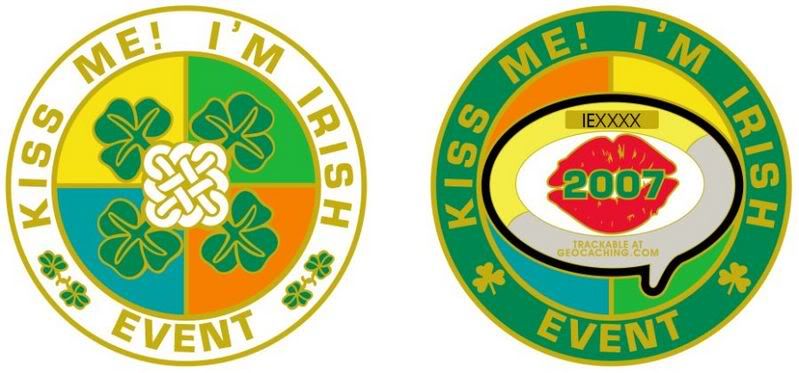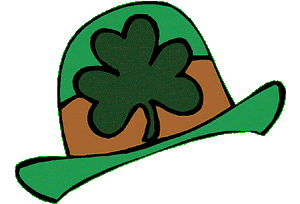
- What: Geocaching Meet and Greet
- Where: Black River Barn Restaurant, 1178 Route 10 West
Randolph, NJ 07869
- Restaurant Phone: 973-598-9988
- Event Contact: Mark, Avroair
- Where: Black River Barn Restaurant
- Time: Noon till 3 p.m.
- Why: To celebrate the first green of Spring ( To dust
off all that caching inactivity during the
winter!)!
|
Please RSVP on this cache page so I can tell the pub a final
tally
This special event will be held in conjunction with similar
events hosted by Avroair, Marky, TheAlabamaRambler and Gridlox. A
Kiss Me I'm Irish Geocoin is available, with a different metal
finish for each event. 100 will be made in each finish.
Links to concurrent events
UTAH CALIFORNIA
NEW JERSEY
ALABAMA
 History of the Holiday
History of the Holiday
Much Irish folklore surrounds St. Patrick's Day. Not much of it
is actually substantiated. As long as there's cheap beer nobody
cares! We're All Irish on St. Paddy's Day!
The person who was to become St. Patrick, the
patron saint of Ireland, was born in Wales about AD 385. His given
name was Maewyn, and he almost didn't get the job of bishop of
Ireland because he lacked the required scholarship.
Far from being a saint, until he was 16, he considered himself a
pagan. At that age, he was sold into slavery by a group of Irish
marauders that raided his village. During his captivity, he became
closer to God.
He escaped from slavery after six years and went to Gaul where
he studied in the monastery under St. Germain, bishop of Auxerre
for a period of twelve years. During his training he became aware
that his calling was to convert the pagans to Christianity.
His wishes were to return to Ireland, to convert the native
pagans to Christianity. But his superiors instead appointed St.
Palladius. But two years later, Palladius transferred to Scotland.
Patrick, having adopted that Christian name earlier, was then
appointed as second bishop to Ireland.
Patrick was quite successful at winning converts. And this fact
upset the Celtic Druids. Patrick was arrested several times, but
escaped each time. He traveled throughout Ireland, establishing
monasteries across the country. He also set up schools and churches
which would aid him in his conversion of the Irish country to
Christianity.
His mission in Ireland lasted for thirty years. After that time,
Patrick retired to County Down. He died on March 17 in AD 461. That
day has been commemorated as St. Patrick's Day ever since.
Some of this lore includes the belief that Patrick raised people
from the dead. He also is said to have given a sermon from a
hilltop that drove all the snakes from Ireland. Of course, no
snakes were ever native to Ireland, and some people think this is a
metaphor for the conversion of the pagans. Though originally a
Catholic holy day, St. Patrick's Day has evolved into more of a
secular holiday.
One traditional icon of the day is the shamrock. This icon stems
from a more bona fide Irish tale that tells how Patrick used the
three-leafed shamrock to explain the Trinity. He used it in his
sermons to represent how the Father, the Son, and the Holy Spirit
could all exist as separate elements of the same entity. His
followers adopted the custom of wearing a shamrock on his feast
day.
The St. Patrick's Day custom came to America in 1737. That was
the first year St. Patrick's Day was publicly celebrated in this
country, in Boston.
Today, people celebrate the day with parades, wearing of the
green, and drinking beer. One reason St. Patrick's Day might have
become so popular is that it takes place just a few days before the
first day of spring. One might say it has become the first green of
spring.
The Shamrock

|
In written English, the first reference to the Shamrock dates
from 1571, and in written Irish, as seamrog, from 1707. As a badge
to be worn on the lapel on the Saint's feast day, it is referred to
for the first time as late as 1681.
The Shamrock was used as an emblem by the Irish Volunteers in
the era of Grattan's Parliament in the 1770's, before '98 and The
Act of Union.
So rebellious did the wearing of the Shamrock eventually appear,
that in Queen Victoria's time Irish regiments were forbidden to
display it. At that time it became the custom for civilians to wear
a little paper cross colored red and green.
As a symbol of Ireland it has long been integrated into the
symbol of the United Kingdom, along with the Rose, the Thistle and
the Leek of England, Scotland and Wales. So today, on St. Patrick's
Day, a member of the British Royal Family presents a Shamrock to
the Irish Guards regiment of the British
Army. |
The Leprechaun and The Pot O' Gold

|
The Leprechaun is an Irish fairy. (I really should just stop
right there!).
He looks like a small, old man (about 2 feet tall), often
dressed like a shoemaker, with a cocked hat and a leather
apron.
According to legend, leprechauns are aloof and unfriendly, live
alone, and pass the time making shoes.
They also possess a hidden pot of gold!
Treasure hunters can often track down a leprechaun by the sound
of his shoemaker's hammer. If caught, he can be forced (with the
threat of bodily violence) to reveal the whereabouts of his
treasure, but the captor must keep their eyes on him every
second.
If the captor's eyes leave the leprechaun (and he often tricks
them into looking away), he vanishes and all hopes of finding the
treasure are lost. |
An Irish Blessing
Near a misty stream in Ireland in the hollow of a tree
Live mystical, magical leprechauns
who are clever as can be
With their pointed ears, and turned up toes and little coats of
green
The leprechauns busily make their shoes and try hard not to be
seen.
Only those who really believe have seen these little elves
And if we are all believers
We can surely see for ourselves.
|
The Blarney Stone

|
The Blarney Stone is a stone set in the wall of the Blarney
Castle tower in the Irish village of Blarney.
Kissing the stone is supposed to bring the kisser the gift of
persuasive eloquence (blarney).
The castle was built in 1446 by Cormac Laidhiv McCarthy (Lord of
Muskerry). Its walls are 18 feet thick (necessary to thwart attacks
by Cromwellians and William III's troops).
Thousands of tourists a year still visit the castle.
The origins of the Blarney Stone's magical properties aren't
clear, but one legend says that an old woman cast a spell on the
stone to reward a king who had saved her from drowning.
Kissing the stone while under the spell gave the king the
ability to speak sweetly and convincingly.
It's tough to reach the stone... it's between the main castle
wall and the parapet. Kissers have to stretch to their back and
bend backward (and downward), holding iron bars for
support. |
See You There!
Black River
Barn Website